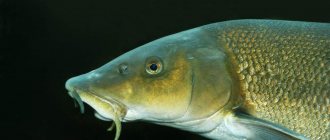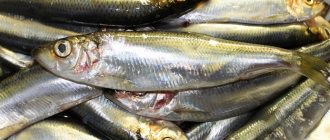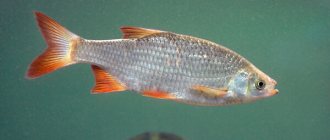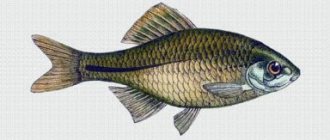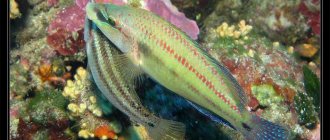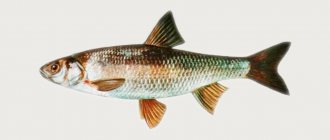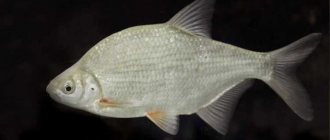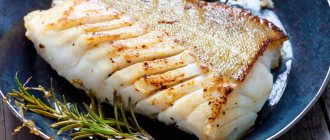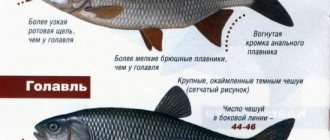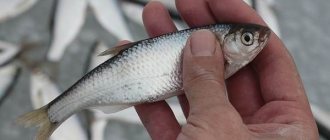The barbel is a fairly large fish, it can grow up to 1 meter and gain a weight of 12 kg. In fact, many people dream of catching her. She is of serious sporting interest, as she has a strong body. It should be noted that all barbels are dexterous and smart. They won’t just get hooked, even if the bait is one of their favorite delicacies.
The entire genus of fish of the Karpov family differs from the barbel. It is often confused with a gudgeon, but upon closer examination it can still be identified. All thanks to the antennae that are located on the cheeks of this representative. Obviously, it was thanks to them that it got its name.
Description
One of the largest representatives of the Karpov family is the barbel fish. A photo of her against the background of a person, boat or other relatively large object will help to verify this.
Longhorned beetles have a raised back. The body begins to flatten after the dorsal fins, so the main meat is located closer to the head. It is also distinguished by thick lips, since it obtains food at the bottom. And as a result of the fact that they constantly rub against pebbles, they can become damaged. The antennae, located on both sides of the lips, are a kind of radar. If the fish notices food, it will linger on a specific section of the river.
The dorsal fin is short, but quite high. It and the one located in the tail have a gray tint. The rest are a little reddish. The body has no spots, its color scheme is even and silver. But sometimes there are specimens with brownish scales.
The fish's eyes are very small. This is due to the fact that when searching for food, it relies more on its antennae-radars than on its vision. They sit deep and are unlikely to help in any way during the search for food, spawning or general swimming.
Reproduction and lifespan
The entire breeding process takes place in a quiet and calm place, somewhere higher. On the top of a tree, on the roof. Females secrete a special fluid (secret) that attracts a partner. Mating takes about 30 minutes. The female who has received attention remains under the protection and supervision of the male, who accompanies her until the eggs appear.
At the end of the mating season, the male dies, and the female survives it to lay eggs. The female beetle lays up to 100 eggs in cracks in trees and wood parts. She chooses the laying site by smell. Having created a clutch, the insect no longer shows any concern for the offspring.
Larvae emerge from the eggs, then pupae, and only after a few years do they eat through the passages in the tree and crawl out. The larvae themselves, growing, almost reach the length of an adult beetle. The entire life cycle consists of several stages: egg, larva, pupa, adult.
Sometimes longhorned beetles prepare in advance a place for feeding and development of future larvae. They choose small trees and eat the bark around the perimeter in the form of a ring, closer to the root. As a result, the tree begins to slowly die. And the deposited larvae complete the destructive process.
They make a loud crunching sound as they bite into the wood. Sometimes in a dry forest you can even hear this characteristic sound. The larvae are very hardy. They tolerate any unfavorable conditions and live in dry and nutrient-poor trees for many years.
They have a light body color, from white to yellowish. The body itself is soft, slightly flattened, with a well-developed cephalothorax. It is equipped with powerful jaws directed straight forward, which can perform both cutting and chewing functions.
The life cycle of an adult is quite short. The beetle emerges from the pupa in early spring, although for this the larva must have time to “pupate”. If spring is far away, the pupa burrows into the core of the tree and hibernates, waiting for the onset of warmth.
Distribution area
Barbel fish is very common in Russia; photos of fishing enthusiasts with the long-awaited trophy often decorate thematic websites. But the habitat is not oriented to the entire country. In cold regions, the longhorned beetle is extremely rare, if not completely absent. This is due to the fact that at sub-zero water temperatures it simply will not be able to feed. It is difficult for him to get food where its availability is minimal.
Also, the fish in question can be found virtually throughout Europe. The exceptions are England and northern Scandinavia. Also, the longhorned beetle is not found in southern Italy. This is again due to cold climatic conditions or the lack of suitable bodies of water.
Social structure and reproduction
Photo: Lumberjack Beetle
Female lumberjacks lay eggs in the spring. For breeding, they very carefully select a secluded place. This is due to the fact that the place will serve not only as a “roof” over your head, but also as a source of food for the larvae. Most often, eggs are laid in large cracks in wood. Females prefer coniferous species: pine, cedar, spruce. Insects determine the type of tree by its subtle aroma.
Female longhorned beetles can lay varying numbers of eggs. Sometimes their numbers reach several hundred at a time. Two weeks after laying, larvae begin to appear. They are white in color and have an awkward appearance. Longhorn beetle larvae resemble worms and are highly voracious.
Interesting fact: The woodcutter beetle often interbreeds with other species. This leads to the formation of a large number of hybrids.
Woodcutter beetle larvae have strong, powerful jaws and high survival rates. They not only live in wood, but also actively make passages there to search for a new source of food. The appetite of the larvae is monstrous. In large concentrations, they are capable of completely destroying a wooden structure in a short period of time.
Woodcutter beetle larvae live for more than one year. There is a long period before reaching adulthood. For some it is one year, and for some species it is about two years. Adults live a tiny amount of time - no more than twenty-five days.
Habitats
Many fish that are part of the Carp family live mostly in rivers. But sometimes they can be found in lakes or creeks. Such conditions allow only a few representatives to feed. Therefore, if a fisherman is lucky enough to catch a barbel in the lake, it will be incredibly large.
For a short period of time, the population of this fish decreased noticeably. The reason for this was too polluted rivers and the pursuit of trophies. But now the population is gradually recovering. Today you can catch such fish in narrow rivers with an uneven bottom.
If you can find a barbel in a body of water other than a river, it is only because he was too carried away by the journey while searching for food. If there is no current, then the fish will not be able to reproduce, since there are no conditions for this. However, in quiet creeks and reservoirs there is a lot of food, so the largest trophies are found there. Needless to say, it will be easier to catch barbel in the river?
The favorite place for fish is the bottom of the reservoir at a depth of 5-6 meters, which is necessarily covered with pebbles or coarse sand. In this case, the barbel will feed easily and have all the conditions for spawning.
Original diet
What the longhorned beetle eats truly surprises outside observers. Much depends on the type and habitat of the insect. For example, the “Lumberjack” loves to eat pine needles, and the “Bark Beetle” loves to eat young branches. In general, its diet, in addition to wood, consists of the following components:
And if a black longhorned beetle gets into the house, then its menu is supplemented:
- attic beams;
- window frames;
- ceiling rafters;
- various wooden partitions;
- floors.
It’s scary to even imagine what a house with such settlers can turn into. By and large, this is where the longhorned beetle poses a danger to humans. Otherwise, the insect evokes a smile and admiration for its attractive appearance.
Some species of longhorned beetles feed on the sap that the tree secretes. And the barbel “Titan” does without food at all. Therefore, you should not destroy all insects with long mustaches.
Nutrition
Barbel is a fish whose menu is very diverse. But this is not at all the result of an abundance of favorite delicacies. Since longhorned beetles feed on whatever they find on the river bottom, a large menu is driven by the diversity of organic life.
Most often, this fish, part of the Karpov family, eats the eggs of other river inhabitants, as well as larvae. But sometimes she comes across small mollusks, which also make up her diet. Longhorned beetles will refuse food only if it does not fit into their mouth.
This fish does not disdain various waste. If the remains of animals after a slaughterhouse are thrown into the river, then the longhorned beetles will live happily in it.
Often fish eat crustaceans or algae, but not all of them, but only those that suit their taste. Smaller river inhabitants can also become prey for barbel. In short, he will eat whatever he finds at the bottom, even if it is small fish or waste from a slaughterhouse.
Origin of the species and description
Photo: Lumberjack Beetle
Lumberjacks are a very large family of beetles. They belong to the order Coleoptera and occupy fifth place in the number of species. As already noted, today scientists count more than twenty-five thousand varieties. The beetles got their name “woodcutter” due to their special “love” for wood. They not only eat wood, but also build their homes in it.
Interesting fact: The Titan Lumberjack is recognized as the largest beetle in the world. The length of its body can reach twenty-two centimeters. However, such a huge insect cannot be found in museums. The individuals presented for public viewing are no more than seventeen centimeters long.
Due to the fact that the wood is consumed by these beetles as food, they are considered pests. These insects cause enormous damage to human property, various buildings, and the environment. This multifaceted creature is distributed almost throughout the globe. The only exceptions are very cold areas of planet Earth. The largest populations are found in tropical regions.
A unique feature of these animals is their mustache. They are segmented, most often exceeding the length of the body itself by several times. Also a characteristic feature are the wings. However, not all members of the family can use them. Only a few species are endowed with the ability to fly. Woodcutter beetles, which are large in size, often look very clumsy when flying.
Lifestyle
The barbel is a fish that only occasionally prefers company. She usually leads a solitary life. But she has to step over her principles during the winter stay and spawning period. Then the barbels gather in schools.
The fish feeds late at night. Sometimes she continues to swim in search of food in the early morning. In addition, the barbel may go out hunting during the day in the fall or spring, when the temperature at night is too low.
For the winter, all the fish in question hide in burrows or depressions, since the water in them is warmer. At this time they have almost nothing to eat, so they do not waste energy on this process and actually do not come out of hiding.
There is no predisposition to migration in fish. She will only swim across in search of a new home if her river is too polluted.
During the daytime, barbels descend to the bottom. In addition, the larger the fish, the greater the depth it will need in order to feel normal. It reaches its greatest activity in the pre-dawn hours, and then you need to catch it.
Lifestyle and habitat
The longhorned beetle lives throughout the planet where there are forests. Their distribution depends on the availability of food - mainly trees. The exceptions are the Arctic and Antarctic, precisely because of the lack of food supply.
They are quite active in their lifestyle. They crawl, many very quickly. Some of them can fly. If you pick up a beetle, it makes a characteristic chirping sound. Their lifestyle depends on the climate and habitat.
In the southern regions, these insects “take wing” from mid-spring. Central Asian beetles begin to fly closer to autumn. Some are active during the day, feeding mainly on flowers that open during the day. Others are active at night. Their food does not hide in the dark.
Both nocturnal and daytime beetles find hard-to-reach places to rest or mate. Depending on the size, the flight range is determined. The larger the beetle, the less it flies and the more it crawls. They lead a very secretive lifestyle. Seeing an adult beetle in the forest is a real gift for an entomologist and an alarming signal for a forester.
Reproduction
The barbel is a fish that reaches sexual maturity at 2 years, but females become ready to spawn a little later. An important condition for mating to occur is the appropriate water temperature. It should fluctuate approximately in the range of 14-20 degrees. This means that the favorable time for spawning is late spring or early summer.
During one spawning process, the female leaves 1-2.5 thousand eggs. Most of them are quite large in size, from 2 millimeters. It is important to remember that barbel caviar is poisonous. Moreover, during the spawning period it is highly not recommended to eat its meat.
After hatching, the fry are carried down by the current. But after a few months, having grown stronger, the juveniles come to the surface. Further, until reaching puberty, the fish stay in large schools. Only after spawning does it switch to a solitary lifestyle.
Detailed description of a dangerous insect
Quite often, longhorned beetles are called lumberjacks, since they can turn the trunks of powerful trees or shrubs into dust. If insects appear in a wooden house, you should get rid of it immediately. Let's look at what this “cute” pest looks like:
- Most individuals grow up to 3 cm in length, although there are also giants.
- The body is elongated, covered with a pair of black or brown wings. Adult representatives of longhorned beetles are capable of flying long distances.
- A special advantage is the jaws. Thanks to their strength, the insect can easily gnaw through wood, turning it into powder.
- Business card - mustache. In some species, their length is 4 times the size of the insect itself.
The longhorned beetle shown in the photo gives a complete picture of this pest. If you look at it carefully and remember the main features, it will be easier to deal with it. This means knowing your enemy by sight.
Large longhorned beetles are especially striking:
- The Titan Lumberjack grows to a maximum length of 16 cm.
- The Brazilian bigtooth can reach 17 cm in length.
- Ussuri relict barbel - approximately 11 cm.
- A black-colored insect only up to 4 cm.
As can be seen from the images shown, longhorned beetles have different body structure, color and design of the elytra. Some of them boast menacing spines, graceful outgrowths or tubercles on the surface of the back.
No matter how attractive the beetle may look, you need to get rid of it immediately.
Barbel fishing
The fish in question from the Karpov family, despite all the difficulties, after mastering some skills, begins to be caught quite well. The main thing is to choose the right bait. Most often, fishermen use larvae or minced meat. Bait should not be used in large quantities, especially if fishing takes place during the day. If a barbel notices a large piece of meat, it will be afraid of it. When fishing is focused on the night, the fish will rely only on instinct and can grab a large piece.
The same can be said about complementary foods. Only small food will be eaten by barbel fish. The Carp family generally does not like large baits, as well as complementary foods.
You can fish with a fishing rod, but you need to make sure that the gear is strong. The barbel is aggressive, it can simply escape if it is not caught in time.
Life cycle of longhorned beetles
The life cycle of most species of longhorned beetles takes 1-2 years. The female beetle lays several hundred, up to 400 eggs in a suitable place - a moistened grass substrate, in soft bark, having previously made a hole, in a gap between boards or in a defect in a log or board. The female can lay eggs even in a tiny piece of bark, in the hope that in the future the larva will take care of itself by gnawing through hard wood. Some species lay their eggs one at a time in the bark, gnawing out a separate cavity for each egg.
barbel larva
The main condition for the successful development of larvae from eggs is warmth and humidity. The larva is a white worm without legs, but with tenacious outgrowths along the edges of the body and with a dark head, armed with powerful jaws capable of gnawing through any wood. Different species of longhorned beetles prefer different types of wood, but in general most beetles are capable of feeding on any tree. Since there are many larvae, one clutch can immediately cause serious harm.
With the onset of cold weather, the larva goes deep into the tree species and waits out unfavorable conditions. With warming and the return of full humidity, the larva returns to the outer layers of the wood, successfully pupates, passes the adult stage, gnaws its way to the surface and a new adult beetle is born.
barbel larva
The viability of the larvae is very high. Scientists consider these beetles to be the same age as dinosaurs, which have quite successfully survived in all their diversity to the present day. Under unfavorable conditions, the larvae seem to be preserved inside the wood and can remain viable for decades. If there is insufficient nutrition, the underfed larvae produce small beetles after pupation.
barbel pupa
After birth, an adult beetle lives only a few months, until about mid-summer. During this time, the beetles manage to migrate, find suitable partners, and arrange clutches.
Barbel fish
Barbel fish. Probably, many people have never heard of this fish. Miron is found only in western and southern Russia and is not known at all in the Volga basin, much less in the northern provinces. True, it has long been known that barbel is found in the lower reaches of the Volga, but recent studies have shown that this barbel is a very special species and enters there by chance in schools of other fish.
In general, the genus of longhorned beetles, which is very numerous in species, belongs to Southern and Central Europe, as well as Central Asia; not a single Barbus is known in Siberia, but in the Turkestan region, as currently known, there are 3-4 different barbels, and in addition, at least five more are found in the Caspian Sea and partly in the rivers of the south-eastern Caucasus.
Almost all Caspian barbels, however, are quite similar to Barbus barbus and even, perhaps, separated from it in recent geological epochs, after the separation of the Black Sea from the Caspian Sea. But we will leave all these very little-known, actually Asian, longhorned beetles alone for now and move on to the main, European representative of this genus.
Barbel fish
The common barbel is found in England, France, throughout Germany and Austria and in the southwestern part of Russia. In our rivers flowing into the Baltic Sea, it is not found at all, and only in the Vistula is another species found (Barbus petenyi). However, judging by the description of Mr. Kurbatov, this barbel (no more than 2-3 pounds) recently appeared in the Neman. Myron’s main residence is the Dnieper, where his favorite refuge is the Dnieper rapids and the so-called. fences, also the Dniester, Bug and all the main tributaries of these rivers, especially the Goryn and Styr. In all likelihood, it goes very far up here, since in the Dnieper, near Smolensk, and in Desna, near Bryansk, fishermen rank it among the most common fish.
In addition, barbel is found in large numbers in the rivers of the Crimean peninsula, such as the Salgir and Alma, but in general it does not like cold water, as well as very warm and strongly illuminated by the sun. In the Don it is already quite rare, but it reaches Kremenchug and Pavlovsk, and is sometimes seen in Psle and even in the Seym, although very rarely, and then only in early spring, before the river has yet entered the banks.
In Voronezh and other rivers of the Don basin it seems to no longer exist. Barbels are easily distinguished from all other fish by their prominent trunk-shaped snout and 4 long mustaches, two of which are located at the end of the upper lip covering the lower lip, and the other two are located at the corners of the mouth. Its body is long, almost cylindrical, olive green above, white below; eyes small, light brown; the dorsal fin is bluish, and its first bony ray is serrated: the remaining fins are more or less reddish.
In general, this fish, both in Europe and in Russia, apparently represents quite a lot of modifications: for example, we have Dniester madder, according to Prof. Kessler, differs from the Dnieper in having very wide pectoral and ventral fins and a much lighter color. The latter also has fins, especially the caudal one, of a very bright red color, and even the dorsal one has a reddish tint.
The pharyngeal teeth, 10 on each side, are identical in both varieties, have a spoon shape and are arranged in three rows (2. 3. 5). Madder belongs to quite large fish. According to the testimony of Dnieper fishermen, barbel weighing thirty pounds are occasionally encountered, but usually they rarely reach a size of more than an arshin and 10 pounds of weight. The average lifespan of these fish is 15-20 years; They grow very quickly, but become fertile only in the fourth year; according to Blanchard, males reach sexual maturity earlier than females, which is very likely.
Small barbels live b. h. on small rocky rifts, often found together with minnows and then very similar to the latter, differing only in small scales, 4 antennae and an elongated snout. Adults also prefer fast, fairly fresh and clean water; this is partly the reason for their rarity in the Don and absence in the Volga.
They are never found in lakes or stagnant waters in general. Adult myrons b. h. stay in rocky, although deep places of rivers, most readily near bridges, mills, piles, under piers, often hiding in holes under the bank or lying in small but deep holes in the river bed. Holds on b. h. at the very bottom, where it gets its food, consisting mainly of worms, shells, and occasionally, despite its large mouth, small fish.
In small places they are only noticed during a spill. Then barbels often swim close to the shores and in flood meadows at such a shallow depth that the back feather protrudes from the water. They are attracted here by the abundance of various animals and plant remains, since they also feed on silt, animal ejections, even carrion (which is why they are often found near drainpipes) and worms, which they very skillfully dig out of the turf with their cartilaginous trunk-like nose.
Sometimes, however, barbels also come out in the summer onto sandbanks overgrown with grass, more often in the mornings and at dusk, even at night, since they generally lead a more nocturnal lifestyle. This is a very strong, agile and lively fish, as can be seen from its large fins, body shape and the force with which it takes in and pushes out water when breathing. Myrons are very fast in their movements, often jumping out of the water, and their jumps sometimes reach amazing heights.
Moreover, they rarely lead a sedentary lifestyle, but constantly move from one place to another and are more often found alone or in small flocks, and even more so in the lower reaches of rivers. Large flocks are noticed only during spawning, which, according to Dnieper fishermen, occurs in early May, when pear and elderberry trees bloom. In general, the spawning time of barbel, like other fish, completely depends on the weather conditions, and therefore is always more accurately determined by the flowering and blooming of plant leaves.
Then the barbels gather in groups of several dozen or hundreds and walk in a long line far upstream, with females swimming ahead, then large males; The procession is finally closed by the youngest 1/2-pound (one-year-old!) moloshniks, apparently not yet fully developed. There are usually more males than females, and sometimes several eggs follow one eggshell, which can be easily distinguished by small grains on the crown and back, where they look like one continuous row.
Most spawning occurs in deep and fast water, on a rocky or sandy bottom. The eggs are mostly spawned on stones. Females remain at the spawning sites for some time, then move into the fastest water, even under waterfalls. Myron eggs are orange in color and relatively very large and few in number: in an average-sized female there are no more than 800 eggs the size of a millet grain; The milk of males is reddish in color.
For the development of eggs, a temperature of 8-10° R is required, and the embryos emerge from the shells after 9-15 days. Young fish grow very quickly, so that at 4 months they reach the size of a large minnow. It is remarkable that the caviar of these fish in many parts of Europe is considered poisonous and is not eaten. The effect of this caviar and the reasons for its toxicity, however, have not been studied at all, and opinions here differ: according to some, poisoning with barbel caviar has some similarities with belladonna poisoning, according to others (Blanchard), poisoning is followed by cholera attacks (vomiting, diarrhea).
Some, finally, like the famous ichthyologist Bloch, completely reject its toxicity. In winter, myrons, apparently, again gather in large flocks, lie in close masses in the deepest places of the river and spend all their time in the so-called. hibernation. At least in France, in winter they found barbel, hiding in large numbers under bridge abutments and sunken barges, where they lay so quietly that they could easily be caught on a bare hook like the aforementioned samoder (see “Catfish” and “Carp”) , even with your hands.
In Russia, however, it seems that no one has yet noticed the winter sleep of longhorned beetles. Catching mirons does not present any special features, and they are usually caught in small numbers along with other fish - in seines and other fishing gear. Moreover, it is a very lively and, in addition, cautious and cunning fish. The main fishing for it, of course, is carried out in the spring during spawning and in late autumn, and most of all it is caught in the lower reaches of rivers.
According to Kessler, Ekaterinoslav fishermen often pull several hundred pieces of this fish into one boat. The white and quite tasty meat of the barbel is very bony and therefore does not have much value here in southwestern Russia and is respected, it seems, only by some (Jews), who alone know how to cook barbel well with various spices. Undercooked meat of this fish, according to Radkevich, causes indigestion, while caviar is considered positively harmful.
Recently, many new species of barbel and related fish have been discovered in the Caucasus and Turkestan region, as well as in Balkhash. Of these barbels, only one, the blunt-nosed barbel, is sometimes found at the mouths of the Volga, but its main habitat is the Caspian Sea and the Aral Sea, from where it enters in significant numbers into the Kura (in autumn), the Syr and Amu Darya.
The blunt-nosed barbel (Barbus brachycephalus Kessl, s. oblusirostris Kessl) differs from the common one by a short, relatively small head, very small and widely spaced eyes, a very blunt nose, a more elongated body and smaller scales (70-75 scales on the lateral line). It reaches a very large size - 29 inches. Bulat-may, or yellow barbel (Barbus chalybatus Pall., s. Capito Nordm), is distinguished by large scales, dark (steel) color on the upper side of the body and pale yellowish lower side and smaller size (up to 40 centimeters).
It is found in the southern parts of the Caspian Sea and in the rivers that flow here. Murza (Barbus mystaceus) is also a small fish (up to a pound), but has small scales (94-100 scales on the lateral line), and is mainly characterized by an extremely fleshy and trunk-shaped snout and lower lip, divided into three lobes. In addition to the Kura and its tributaries, the Murza, or rather a species very close to it (Conocephalus Kessl), is also found in the Turkestan region.
Two or three more species of longhorned beetles with speckles on the body have been found in the Caucasus. Of these, Barbus dscaucasicus), found in the Terek, Kum and other rivers of the Caspian Sea, is of medium size (up to 40 centimeters), reddish-gray in color with dark gray spots and specks (especially sharp in young specimens) on the body and on the dorsal and tail fins and with light red lower fins.
In the Kura, Araks and their tributaries there lives an even more motley small barbel, Barbus caucasicus, with numerous black-brown spots on the sides, dorsal and caudal fins, a whitish belly and red or reddish lower fins. The Gokcha barbel (V. goktschaicus) from Lake Gokcha, with a yellowish belly and more variegated fins, comes very close to it. In the upper Kura and its tributaries there is a hump-nosed barbel (B. cyri), also motley, but distinguished by a strongly curved snout.
In Transcaucasian rivers there are also fish that are very close to barbels, the so-called. Khramuli, with one pair of antennae and large scales, which is why they are assigned to another genus (Capoeta). The most famous of them is titul, or temple (Capolta fundulus); Georgians have bolotsiteli, i.e. red tail, up to 13 inches. length, body structure reminiscent of a chub and found in the Kura, Araks, Rion and their tributaries, especially in the river. Temple (hence the name temple).
It does not seem to be found in the Caspian Sea and loves fast river water. Very close to it is the Gokchi temple (kogak among the Armenians, kora-balih among the Tatars) from Lake. Gokcha, which differs almost only in that its scales are not silver, but golden. In the Turkestan region, in addition to the barbel itself, common with the Caspian (B. mystaceus, brachycephalus and caucasicus), there are quite a few species of the so-called. marinok (Schizothorax), differing from barbels by very small scales (almost like tench) and special large scales at the anus.
The very upper reaches of the rivers are inhabited by the so-called. Ottomans (Diptychus), replacing here trout, found only in a few tributaries of the Amu Darya. Ottomans live at altitudes of up to 10,000 feet. and differ from longhorned beetles and marinkas by two antennae (like Capolta), and mainly by the fact that the sides and tail of the body are covered with small, completely scattered sparse scales; the belly is completely bare, and only on the sides of the anal fin are large scales.
Despite the fact that myron has a fairly wide distribution in our country and, as one of the strongest and most lively fish, enjoys great respect among hunters and fishermen of the Dnieper basin, until recently there was almost no information about its fishing in Russia, except superficial indications about that Mr. Radkevich.
Only now, after the notes of Mr. Korde and Voronin, and mainly the articles of P.Z. and Borisov about fishing for Miron in Desna and Bolva, you can get some idea about catching fish this way for a hunter. In the Vistula, madder (Barbus petenyi) is caught, according to Voronin, by very few fishermen. In general, the Poles do not like fishing, and besides, the very fast, always muddy Vistula with its extremely changeable banks and depth is not particularly conducive to fishing.
Fishing is done in fast and relatively shallow places, and the more the sand moves at the bottom and the muddier the water, the more frequent the bite. The best place is considered to be the edge of the shallows between the middle of the river and a deep place near the shore. Here they fish by hand (without a fishing rod, in a reverse position), with a half-pound sinker, and a small cork float, about the size of a pea, is put on 6 inches from the hook to raise the hook; otherwise it will now be washed away by sand.
The hook is small, like for ruffs, and is attached with a small ball of cheese, preferably Swiss. Due to the strong current, heavy load and careful bite, misfires are not uncommon. In the upper reaches of the Dnieper, in the Smolensk province (Korda), myron is also caught on the bottom with a very heavy sinker, from 1/4 to 1/2 lb., in the fastest places of the river and with very strong gear.
The nozzle is: 1) small molting crayfish or crayfish neck; 2) millet dough, which is inconvenient because it easily comes off the hook and is washed away by the fast current; 3) a spindle (probably a brook lamprey and its larva - a blind bindweed) up to 4 arsh long; it is found in the soft silt-clay bottom, taken out with a scoop or dug out by hand. This attachment is considered almost the best here.
The hook is threaded into the mouth of the spindle, and the sting and barb are released outward, certainly from below, at a distance of 1/2 inch from the mouth. In addition to the fishing of myron in the upper reaches of the Dnieper, from the words of one of the former Smolensk fishermen, Glukhovsky, who lived on the Dnieper 15-20 years ago, I can report that myrons are caught here mostly from boats, on pokes (poles) stuck into the shore or not far from it; due to the fast current, otherwise it is impossible to stay in place here.
The main bait here is the molting crayfish, less often the crawling crayfish. To attract myrons, they are often caught with a bait consisting of cakes with bran and dough, so that it is not washed away so quickly by the current. All this is placed in sacks or bags, which are tied with string to a fairly long stick or pole, with a loop at the opposite end, put on a driven (permanent) stake or stakes.
These stakes and baits constitute the inalienable property of the owner and may not be used by others. Myrons very soon approach the bait and begin to push the bag with their nose, which is recognized (if it is suspended) by the shock transmitted by the stick. Some Upper Dnieper fishermen take advantage of this courage of the myron and catch it with the so-called “under the ligature”, namely: 2-4 hooks with a nozzle (crayfish) are tied to a bag on short strong leashes.
Myron, grabbing the crayfish, hooks himself and pulls out along with the bag; if it is very large, then you have to remove the pole from the stakes and let the fish drag it along with the bag until it gets completely tired. It seems that ordinary fishermen catch myrons here using thread lines, just like vimba (cheese), only thicker ones. These fishing lines are prepared (twisted) by the fishermen themselves from selected home-spun threads and in strength they seem to be little inferior to raw silk.
According to the same person, Smolensk fishermen caught Mirons up to 20 pounds. weight. On the lower Dnieper, according to Dombrovsky, they catch madder on stone towns, just like in Volyn: they sit on a stone and cast a long bottom fishing rod with a crayfish downstream. According to Radkevich, it is best to fish for madder on a bottom fishing rod with hook No. 1-3, but you can also fish with a float rod and a line.
The place must be fed. Hooks are baited with earthworms, a bunch of worms, omentum, and crayfish. A hooked madder almost always seems to rush against the current, and if the angler has hooked a madder, which is recognized by two strong shocks, then he must immediately get up and quickly follow the fish, not allowing it to pull the line in line with the rod and allowing the lace to unwind from the reel , if you fish with one, which is almost necessary.
In Desna and Bolva, local fishermen fish for myron mostly on the bottom. This is explained by the fact that a bottom fishing rod is more convenient for night fishing for large fish, as it can be much coarser and stronger. According to P.Z.’s observations, myron lives here mostly in pits and under writhing places, in quick places where a net cannot catch him, which is why he is caught in a net only in muddy water. The most complete information about chub fish is here.
Mostly small myrons hang on the rifts, while large ones love a calmer (and deeper) current, although they are never caught in very quiet places; Often he comes ashore and gets aground where you don’t expect him at all. Fishing begins now after spawning, and by mid-June the real fishing is already over, although barbel continues to be caught occasionally until mid-August, and in very good and warm weather, according to local fishermen, it is caught even in early October.
In good weather, myron begins to bite from the beginning of May, but in bad weather and cold weather the bite is sometimes delayed until the twenties. In a strong and cold wind, in bad weather and turbidity, fishing is always unsuccessful; the same during a thunderstorm. At first, the bait is a large earthworm; later, in June, the myron catches well on the large claw of a molting crayfish.
It is best caught at dawn. The author fished for Mirons (not particularly large ones) on long solid rods with a reel, but with a hairline (16-20 hairs), which, of course, does not stand up to criticism: no float was used, so it is the same bottom fishing rod. Hooks for small barbel were taken No. 1, for large ones - 3/0. Myron is especially strong in the first moments after hooking; at this time, you need to let him wind the lace freely, without fear that he will get stuck under the cramp, which he strives to do when he begins to weaken.
Therefore, after the first gusts, you need to pull the line as tight as possible. Most of all, you need to be careful when Myron goes deeper. This means that he saw a snag and wants to go under it, and therefore the whole task is to prevent him from moving at this time and take him away from the dangerous place. If the myron goes under the cramp, then you need to keep the line very taut, since it often happens that the myron (forced by pain) comes out from under the cramp.
If this did not work, then the following device was used: a willow ring with a diameter of 2 1/2 inches was tightly screwed to the end of the longest rod. This ring was passed through the thick end of the fishing rod, which was used for fishing, and it was brought along the fishing line to the hook. Of course, this is only possible when the driftwood is close to the shore. According to Mr. P.Z., Myron is quite capricious and it often happens that he doesn’t take one bait at all, but does well with another.
He also tried, and successfully, to replace the coil with a rubber tube (see “Carp”). Nothing is known about the fishing of Caucasian longhorned beetles. In the tributaries of the Kuban (Zelenchuk, Urup, etc.) they are said to take well on moonlit nights. In Kura, near Tiflis, barbel seems to be caught almost more often than other fish (on worms, pieces of lamb, lamb heart, etc.).
Here, due to the very fast current, very heavy lead flat sinkers (more than a pound) of the original shape are used for fishing - in the form of a flat hollowed out turnip; In this recess, hooks (5-6?) wrapped in paper are placed, tied on short leashes. The fishing line (string), attached to the sinker, was wound on top in a ball, so that the entire projectile turned out to be very manageable.
At the fishing site, stakes were stuck, to which the end of the string was tied. According to the observations of Mr. V. Borisov, in the same Desna (near Bryansk) who successfully caught myrons on a folding English rod with a reel and silk cord, here the myrons are kept mainly in places where the bank goes from steep to flat, oblique, jutting into the water , and consists of different sizes of lumps and lumps of some kind of brown, iron ore-like mass of the most irregular fracture and hard as stone.
However, he prefers deep places, but only if they have a fast current and the same ferrous-clay bottom. Probably, this ore replaces large stones in the Myrons, which are not found in Desna (near Bryansk). On the deep and fast tributaries of the Desna with a sandy and partly gristly bottom, barbels are found, but it seems only small ones. They never occur in creeks and generally quiet places, and in general they are not found here at all in purely clayey, especially in silty places.
The best proof of the permanent presence of myrons is their throwing out of the water: like carp, barbels “play” only where they live permanently. According to the same author, myron has been caught on the Desna since spring, when the water had not yet completely reached low water, and suburban and urban (Bryansk) fishermen sometimes caught it very successfully using lines baited with crawlers, and, probably, it could be caught Fishing at this time, but only from a boat.
Myron's best bite is b. h. in May (late), precisely during the flowering of wheat, but sometimes (during a rainy spring) it passes to July. At the end of August, myron comes across only by chance. The best time of day for fishing is early morning, before 8 or 9 o'clock; in the evening Myron takes from 3 to 5-6, but it’s worse and b. h. small. The weather, according to the observations of Mr. Borisov, does not have a particular influence on the intensity of the bite, but in a strong wind blowing with or against the current, the myron does not seem to take at all.
The best bait here, as almost everywhere, is considered to be crayfish. “The molting crayfish with its dark green, soft skin is a Myron delicacy.” They probably sense it from afar, since the bite always follows very quickly, and fussing with the caught one scares off the others for a short time. The crayfish is followed by a crawl, which, however, is often tugged at by small myrons; ordinary worms, planted several at a time, are used here only as a last resort.
Bait (pieces of worms or crayfish) is very useful, and even necessary if the bite is bad. Fishing was done from the shore using English tackle with a reel, silk line No. 2, 50 yards long, without a float, with flat sliding weights weighing a spool of 3 each. The largest fished myron pulled out 14 1/2 lbs.
The bite was transmitted directly to the rod lying on the stands; the first push was usually followed by another, and then a pull-up and a hook. Apparently, after hooking, myron most often first flies to the opposite bank; then, if he managed to withstand this impulse, he begins to describe arcs and, having rested, again quickly heads deeper into the depths, repeating these maneuvers several times.
Sometimes it rises to the top, probably with the aim of jumping out, and therefore in this case it is useful to plunge almost the entire rod into the water. The most dangerous thing is when the fish heads towards the shore. Other myrons immediately after hooking lay on the bottom and, despite all efforts, could not be raised up. This is probably done by very large barbels; the middle ones touched a snag, a ledge of the shore (or the mentioned pieces of ore).
At the same time, the movements of the fish can be heard - how it moves its fins and moves its tail - but, despite all the efforts of the fisherman, it does not move. Probably, in such cases, you need to wait for the myron to go into action on its own, as other fishermen advise. Some myrons take the bait from a running start with such force that they break off the leash right at the hook, almost without unwinding the fishing line from the reel.
Small myrons, from 2 pounds or less, take the bait just as decisively as large ones, and, when caught, they differ from large ones in their nimbleness and thievery: they either fly up, then pull into the depths and fly from there to the side or to the shore. Mr. Lintvarev says a few words about madder fishing on the Dniester and its tributary Smotrich, as well as on the Berezina. On the Dniester and Smotrich, this fish constantly stays on the bottom, completely strewn with large stones, under which it has a permanent residence.
They fish here, as on the Berezina, with very strong bottom fishing rods with a heavy movable sinker and a string leash. The bait on the Berezina is mainly millet porridge, boiled hard and cut into small cubes. In addition to millet porridge, medium-sized madder takes well (on the Dniester and Smotrich) on worms, while large ones prefer live bait. The bait used (in the south) is mamalyga, i.e. porridge made from corn.
The bite, according to the author, is expressed in a strong and jerky pull. Large madder can easily tear the rod out of your hands. A hooked barbel exhibits very strong resistance and, with the speed of its movements and desperate jumps, is significantly superior to the chub. In rocky places, madder cannot be caught otherwise than with a long (no shorter than 2 arshins) string leash, since after hooking it immediately hides under a stone, and if you drag the fish towards you, the line will certainly be cut on the sharp edges of the stone.
Therefore, if madder gets stuck under a stone, they do not try to pull it out from there, but keep the line slightly slack and wait patiently (sometimes ten minutes) until it comes out from under the stone. As soon as the angler feels by pulling the fishing line that the madder is floating out from under him, then he gradually releases the fishing line, trying to keep it slack all the time. Having released a little fishing line and thus giving the fish the opportunity to swim out of its ambush, you should quickly drag the madder to the shore.
In this case, it happens that she again touches the stone, and she has to resort to the same trick. Barbel fishing in Western Europe is highly respected by amateurs and almost ranks second after salmon and trout. Barbels are caught especially a lot in London, on the Thames, where they live in large numbers, attracted by the abundance of food. Here, many boatmen make a living by transporting rich fishermen to the places they feed (lard, meat, greaves, worms), who fish for barbel by the pounds here.
In terms of strength, the barbel is not inferior, and in the rapids even surpasses the river carp and our carp, and therefore, due to the fact that fishing for this still quite common fish is in a primitive state in our country and large myrons are caught, probably by very few Western Russians hunters using improved gear, I consider it necessary to make a very detailed description of all fishing methods known in the West, and especially in England.
As far as we know, fishing for barbel abroad is done in two main ways - with a float and on the bottom, in a reverse manner, in both cases, certainly from the bottom, since the myron always stays at the bottom, without floating up, like a gudgeon, and always with bait. As for the latter, it seems to me that there is no need for us, Russian hunters, to completely follow the advice of foreign fishermen, mainly because we generally have more fish of all kinds, and they are, as they say, much “simpler.”
Moreover, in Germany and especially in England, the bait is positively abused to the point of absurdity, and I cannot even decide, like Baron P.G. Cherkasov, to advise, according to Beli, to limit Myron’s bait to only one and a half thousand large worms, since, according to in the latter’s opinion, one cannot follow the words of some writers who say that in order to successfully fish for myrons, one must throw 2 or 3 quarts of worms for 3-4 evenings in a row (a quart is slightly less than 1/10 of a bucket).
It is unlikely that any of the Russian fishermen will fulfill this modest demand of the famous English writer, since, probably, each of them will find that in order to successfully fish a day after bait, one and a half thousand crawls are too many and that this is too enough for to feed and even feed several dozen large fish, which is a little expensive for us (a thousand crawlers are sold in Moscow from 2 to 5 rubles).
Many Russian fishermen believe that fishing with bait is in the same relation to fishing without it, as, for example, shooting wolves on carrion is related to hunting wolves. For our part, recognizing some of the benefits of bait in places of constant fishing, as well as its importance in the case when you have to fish with an unfamiliar bait.
I believe, however, that if you know the area where a certain type of fish lives, in most cases bait thrown or lowered to the bottom during fishing is sufficient, and that it is necessary to bait only those substances that can rarely get into the water, for example cheese, cracklings, etc., and throw this bait in small quantities, but as often as possible. However, I cannot help but notice that Western European fishermen abuse bait no less, if not more.
Bely advises throwing about 20 worms, cut into four parts, for bait at the beginning of fishing; “If after 10 minutes the first portion does not have an effect, you should throw another one. If, continuing to do this for an hour, the fisherman does not achieve success, then let him cut two hundred worms and throw them; If after 20 minutes this portion has no effect, then all that remains is to change the place.”
It seems to me more than unreasonable to advise waiting for a bite for almost an hour and a half (sometimes in a place already fed with 1500 worms) and spending more than 300 worms for bait. In my opinion, if the first portion of bait did not work, it means that there is no fish here or it has not yet arrived, and rather than wait for it to come several tens or even hundreds of fathoms away, attracted by such a mass of worms carried away by the current, wouldn’t it be easier to catch lower, on the same stream.
Both for bait, and for bait and bait when fishing Mirons, in addition to large earthworms, which are most suitable for these purposes, people abroad also use cheese, cracklings, bread, dough, steamed grains, boiled potatoes, boiled beef, bovine brain (head and dorsal), bovine blood, red dung worms, maggots, i.e. blowfly larvae.
Salmon caviar and pieces of lamprey also serve as good bait, but both of these baits, the first in particular, can hardly be used by Russian fishermen, since salmon and barbel are found together only in Caucasian rivers. Cheese - a very common bait for barbel - should be white, soft, viscous and not salty. The most suitable option is ordinary Swiss cheese; but these qualities are necessary only for bait, and for bait they do not have such great importance as is attributed to them.
If the cheese is too dry and therefore brittle, it must first be soaked in a damp cloth, or even better, in milk. Then it is cut into cubes of 3/8 - 1/2 inches, i.e., the size of an ordinary nut, and the corners are slightly rounded. The cheese should have the consistency of rubber, and it is necessary for both bait and bait that it be fresh and not sour.
Myron goes very well with cheese, but it can be fished with a float only in places with a not very strong current, since with frequent rethrowing of the fishing rod, the cheese is more likely to be washed away by the current and more likely to fly off the hook than when fishing on the bottom, at least in rapids. For bait, one and a half pints (a pint is about 1/20 of a bucket) of cheese, cut into cubes, is considered sufficient, and throw it without any foreign matter 30 hours before fishing.
Cracklings, or renderings, are considered better than cheese, especially for bait, for the reason mentioned, but for bait by some, for example. Beli, are not approved on the grounds that although “there is not a single bait with which it would be possible to catch 3-4 myrons one after another so quickly, as with melting ones, they so quickly satiate the fish that it can only eat them in a small amount." Therefore, he advises throwing in little cracklings only during fishing, constantly changing places.
From the fact that the fish soon become bored with the fish, it seems that one can only conclude that they should be thrown in for a smaller bait, and this should rather be seen as some kind of convenience. Before using the firewood, they are first smashed with a hammer, placed in a pan of water and boiled for 20 minutes, stirring frequently; then they are cooled and the best, i.e. whitest, pieces are selected for baiting.
With greaves, just like with cheese, they are caught in not very strong currents and mainly in the second half of summer. Blood is used only for bait in a bladder with a small puncture and with a stone attached. Fishermen in Germany (according to Moerbe) place sheaves of flax in the water to attach barbel. However, even in the last century Bloch attributed the taste and fat of barbels to r. Weser to the fact that a lot of flax was urinating in this river at that time.
There is no doubt that one of the best baits for most fish can be flax and hemp meat (duranda, marc, kolob), which in some places (in Vyatka and other provinces) is also used for bait when catching bream, ide and other whites Myron is very willing to use maggots, as well as red dung worms, but, unfortunately, both of these attachments are very inconvenient, because they are eaten by small things.
Maggots are placed on a hook (No. usually 3-4 pieces; red worms - also 2-3 each (No. 6-7). The former are most suitable for fishing in the summer, in clear water, and the latter, like crawlies, for fishing in spring and autumn in muddy water, as well as during night fishing in the summer, when another, less bright, bait is hardly noticeable.To bait, maggots can be thrown in no other way than in clay balls, and the maggot is like a filling, and the clay (which must be well washed) is the dough.
The French usually mix maggots in clay along with horse feces, which in itself serves as a good bait for myron. For this purpose, they advise red worms to be cut into pieces and kneaded into clay or (if the current is weaker) into balls of butter bread, which is scalded with boiling water and generously sprinkled with scraped cheese. In France, they catch (and feed) barbel, especially at the end of summer, also on pieces of raw dough with lamb fat and on pieces of beef boiled with garlic.
An excellent spring bait is a midge larva living in tubes, but it is very delicate and does not hold well in fast water. Place 2-3 larvae on hook No. 6-8. Moerbe advises using leeches as bait, in the absence of live ones, even dried and soaked in water. He also recommends for barbel a bait made from a mixture of cottage cheese, yolk and camphor, which (i.e. the mixture) is wrapped in a cloth.
Author L.P.Sabaneev
Longhorned beetle: how to get rid of it?
The barbel pest poses no danger to humans. It is only dangerous for the tree.
Special means of varied action will help you fight barbels in your own home. Which specific product to choose in this or that case is entirely up to you!
– Contact. They manifest their effect directly upon contact with the longhorned beetle. Such products are not popular because their use can be harmful to human health.
- Intestinal. Such agents include sodium fluoride, zinc chloride and other components that exert their harmful effects on the insect through the intestines.
- Fumigants. These are gaseous and vaporous substances: sulfur dioxide, dichloroethane, etc.
Remember that solid wood, on the surface of which there are no cracks or other defects, is not of interest to pests. The longhorned beetle will live and reproduce only in cracks. Therefore, you can’t go wrong if you pour a special product into the grooves of the wood panel with a syringe, and then cover these holes with wood putty or ordinary plasticine.
Remember that it is very difficult to overcome barbels! It is much easier to resort to preventive methods, for example, using exclusively wood impregnated with fungicides for construction purposes.
Where does it live?
Habitat: Black, Baltic, Caspian Seas, Atlantic Ocean.
The barbel belongs to the category of sedentary fish. In the warm season, he prefers to stick to deep places with fast currents and a rocky bottom. Often found in direct currents, but tries to avoid pools with reverse currents. Favorite places are deep furrows with a pebble, rocky or sandy bottom.
The young generation of fish stays in small schools; they live on the rifts along with the gudgeon. Large individuals live separately. With the arrival of winter, the common barbel lies in holes and burrows under steep river banks, and the bite is practically absent.
Catching barbel in winter is ineffective.
The Crimean barbel lives in the waters of the Western Caucasus and Crimea, the Dagestan barbel lives in the rivers of Dagestan, Terek and Kuma, and the Kura barbel lives in the Kura. There is also the Dnieper barbel; in total there are 9 subspecies of this fish.
Fishing Features
Fishing begins with the complete fall of flowers in the gardens.
They fish with a reel, a bottom line, a bottom fishing rod, and occasionally with a spinning rod and a float rod. The most successful fishing is with bottom wiring and wiring. Bottom fishing is classic in its techniques and does not require a description. It is better to fish in a retrieve with a long release of the float, for which you need to equip a powerful and rigid fishing rod with guide rings and a reel. A small spinning reel with an easy stroke is more suitable, so that the current freely carries the float, winding the line from the reel with slack between the float and the tip of the rod. Lines with a diameter of 0.45 mm with a leash of 0.3–0.35 mm. The line should not be painted, but the leash can be painted light blue. The float is spindle-shaped, somewhat larger than usual for sinkers made of small buckshot or three pellets. For better visibility, it is surrounded only by 2/3 of the length. Straight hooks No. 8–12, which depends on the size of the bait and the weight of the fish expected in the catches. Catching barbel
The best baits are a spindle and a crawler. Earthworms, omentum, bivalve shells, crayfish and its neck, maggot and soft unsalted cheese are also used. To swim the bait in places with different depths and uneven bottoms, you have to control the gear, which is sometimes tiring and makes it difficult to distinguish bites. Shallow places pass, holding the float and causing the bait with sinkers to rise. At the beginning of the retrieve, sometimes you have to feed the line from the reel by hand until the float pulls it on its own. Bait is rarely used; it usually has no effect, often attracting other fish. The barbel hook, even at a long distance to the float, should be sweeping, but not sharp. The hook fits easily into its fleshy mouth.
After hooking, the barbel often rushes against the current, pulls very stubbornly and strongly, pressing against the bottom, often stops, stands up straight, with its head in the bottom. Both of these techniques can result in dead holds. You need to have time to wind the line onto the reel without allowing it to loosen. Sometimes, with a strong pull, you have to follow the barbel along the shore. Having overcome the first jerk, you must always be ready for a new throw in order to give up the line in time or run after it along the shore. The barbel does not allow itself to be taken out immediately; its resistance is stubborn and long-lasting. In the event of a snag, there is no need to despair; often the barbel frees itself from it; the line should be kept taut and, as soon as it sets off, continue fishing.
Barbel is caught with bottom fishing rods on an uncluttered, clean bottom, usually in the furrows of the fairway, which are quite close to the banks, on a pebble and coarse sand bottom. Lines with a diameter of 0.6 mm with a leash of 0.5 mm, painted sandy color. The leash is connected via a carabiner. The sinker is heavy, weighing up to 150 g, often sliding, but sometimes also an end one, connected to the line through a carabiner. Hook No. 9–12 with a long shank and a bent sting. Animal baits firmly attached to hooks are used as bait. The best one is the spindle. In very fast currents, the line is replaced with steel wire with a diameter of 0.2 mm, which makes it easier for the sinker to stay on the bottom and significantly reduces the number of snags on rocks. The wire is handled carefully, avoiding kinks and “wings”. The bottom line is attached to the tip of a rigid fishing rod and the alarm is closely monitored. When casting long distances, it is necessary to hook the fish; in these cases, self-hooking is a rare occurrence. With a float rod, barbel is caught in the same way as carp and carp - from the bottom and plumb.
Do we know our enemy by sight? Longhorn beetle
The longhorned beetle is considered one of the most unusual insects in nature. Biologists count approximately 26 thousand species of these cute creatures. All of them have a medium-sized body and, of course, long mustaches - the calling card of the insect.
The color of the outer cover depends on the species, and the length of the antennae depends on the gender.
The beetle's body is designed in such a way that it is capable of making various sounds. Therefore, the presence of a pest in the house can be recognized precisely by them.

